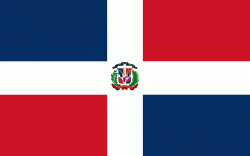Baní
Baní is a capital town of the Peravia Province, Dominican Republic. It is the commercial and manufacturing center in the southern region of Valdesia. The town is located 65 km south of the capital city Santo Domingo.
Baní is the headquarters of the Southcentral General Directorate of the National Police, the Central Regional Directorate of the Ministry of Agriculture and the South Regional Directorate of the General Directorate of Traffic Safety and Land Transport (DIGESETT).
The city of Bani is the capital of the Peravia province; its residents also know it as the home of poets. The province's population is 169,865 people, with 61,864 living in the Bani metro area. This is a tightly knit community with families and neighborhoods dating back several centuries.
Bani is a Taino word meaning "abundant water." The area was named after an important Taino leader of the Maguana people. He was said to be one of Caonabo's closest allies. But, it wasn't until 1764 when a group of neighbors concerned with their security and safety came together to purchase a property large enough to build their own village in the valley of Bani. Historians set the sum of this purchase as that of “300 pesos fuertes” for a property called Cerro Gordo; the principals were listed as Francisco Baez and Bartolome del Castillo.
Its culture and customs were most accurately portrayed in the novel Bani o Engracia y Antoñita, written by Francisco Gregorio Billini. The local beach is "Playa Los Almendros" (Almendros Beach,) situated 6 km south of the center square. The town's original design follows the classic Spanish square, with a park in the center of the town surrounded by the local church and the local government (mayor's office).
The city's Patron Saint is "Nuestra Señora de Regla," whose celebration is on 21 November each year.
Baní is surrounded by many smaller towns, many with their own specific identities. One example is Paya, well known around the country for its milk-based candies (most famously "Dulce de Leche," or Milk Candy.) Another is Salinas, a town by the Salinas bay, where salt is produced. Salinas is famous for its Sand Dunes, that make the Dominican Republic the country with the largest sand dunes in the Caribbean.
Baní is the headquarters of the Southcentral General Directorate of the National Police, the Central Regional Directorate of the Ministry of Agriculture and the South Regional Directorate of the General Directorate of Traffic Safety and Land Transport (DIGESETT).
The city of Bani is the capital of the Peravia province; its residents also know it as the home of poets. The province's population is 169,865 people, with 61,864 living in the Bani metro area. This is a tightly knit community with families and neighborhoods dating back several centuries.
Bani is a Taino word meaning "abundant water." The area was named after an important Taino leader of the Maguana people. He was said to be one of Caonabo's closest allies. But, it wasn't until 1764 when a group of neighbors concerned with their security and safety came together to purchase a property large enough to build their own village in the valley of Bani. Historians set the sum of this purchase as that of “300 pesos fuertes” for a property called Cerro Gordo; the principals were listed as Francisco Baez and Bartolome del Castillo.
Its culture and customs were most accurately portrayed in the novel Bani o Engracia y Antoñita, written by Francisco Gregorio Billini. The local beach is "Playa Los Almendros" (Almendros Beach,) situated 6 km south of the center square. The town's original design follows the classic Spanish square, with a park in the center of the town surrounded by the local church and the local government (mayor's office).
The city's Patron Saint is "Nuestra Señora de Regla," whose celebration is on 21 November each year.
Baní is surrounded by many smaller towns, many with their own specific identities. One example is Paya, well known around the country for its milk-based candies (most famously "Dulce de Leche," or Milk Candy.) Another is Salinas, a town by the Salinas bay, where salt is produced. Salinas is famous for its Sand Dunes, that make the Dominican Republic the country with the largest sand dunes in the Caribbean.
Map - Baní
Map
Country - Dominican_Republic
 |
 |
| Flag of the Dominican Republic | |
The native Taíno people had inhabited Hispaniola before the arrival of Europeans, dividing it into five chiefdoms. They had constructed an advanced farming and hunting society, and were in the process of becoming an organized civilization. The Taínos also inhabited Cuba, Jamaica, Puerto Rico, and the Bahamas. The Genoese mariner Christopher Columbus explored and claimed the island for Castile, landing there on his first voyage in 1492. The colony of Santo Domingo became the site of the first permanent European settlement in the Americas and the first seat of Spanish colonial rule in the New World. It would also become the site to introduce importations of enslaved Africans to the Americas. In 1697, Spain recognized French dominion over the western third of the island, which became the independent state of Haiti in 1804.
Currency / Language
| ISO | Currency | Symbol | Significant figures |
|---|---|---|---|
| DOP | Dominican peso | $ | 2 |
| ISO | Language |
|---|---|
| ES | Spanish language |















